01 Introduction
Data Communication¶
Exchange of data b/w devices via transmission medium, where data is information presented in form agreed by involved parties. Termed from ‘telecommunication’ - communication at a distance
Components of Data Communication¶
- Message
- Sender
- Sending protocol
- Medium
- Receiver
- Receiving protocol
Node¶
Device capable of sending/receiving data to/from other notes on network
Network¶
Set of devices connected by communication links
Purpose¶
Share resourcces
- File sharing
- Hardware sharing
- Application sharing: Client/server apps
- Network graming
- User Commuication
- Voice over IP (VoIP): allows calls over traditional IP rather than by traditional PTSN
Distance-Based Classification¶
| Range | Example | |
|---|---|---|
| LAN | Short | Wifi |
| MAN | Specific area (city, campus) | Cable TV |
| WAN | Long | The Internet |
Parts of Network¶
| Part | Role |
|---|---|
| ‘The Internet’ | |
| Router | Connect internet to ‘The Internet’ has intelligence (represented using \(\otimes\)) |
| Firewall | Rules to adhere on which messages to be allowed |
| Switch | Helps form a LAN (Local Area Network) No of ports will always be \(2^n\) |
| File Server | |
| Database Server | |
| File Server | |
| WiFi Access Point | kinda like a wireless switch connected to wired swetch |
Links between one/more routers should be a ‘dedicated link’
Transmission Modes & Media¶
| Type | Medium | Range | Requires | Example |
|---|---|---|---|---|
| Wired | Twisted Pair Cables | Short | Landline, Ethernet cable | |
| Coaxial Cables | Long | |||
| Fibreoptic Cables | Very Long | |||
| Wireless (Frequency bands) | Radio Waves | Long | Omni-directional antenna | Car radio |
| Micro Waves | Long | Uni-directional Microwave antenna Lon | Etisalat connection tower | |
| Infrared Waves | Short | Bluetooth |
Wireless can - Infrastructure-Based: Mobile Network - Infrastructure-less: Bluetooth
IDK¶
Transmission Modes¶
| Direction | Order | Example | |
|---|---|---|---|
| Simplex | Uni | Car Radio | |
| Half-Duplex | Bi | Sequential (one direction after the other) | Walkie-Talkie |
| Full-Duplex | Bi | Simultaneous (both directions at the same time) | Telephone |
Line Configurations¶
| Example | |
|---|---|
| Point-to-Point | Connection from ISP to home router |
| Multi-Point | Multiple devices connected to a single home router |
Topology¶
Arrangement of nodes in a network
| Bus | Ring | Star | Mesh | Hybrid | |
|---|---|---|---|---|---|
| Arrangement | Sequential | Each node connected to 2 adjacent nodes | Nodes directly connected to a central ‘controller’ | Every device connected to every other device in point-point manner | Combination of star and bus |
| Working | Devices collectively help transfer data b/w points Terminators stop signals after reaching end of wire, to prevent signal bounce | Token-Passing (Token: Message which gives priority to a station to use ring) - Data hops from one device to another until it reaches its destination - Each device communicates its routing info to every other connected device - Each device then determines either passes/keep received data | |||
| Device Used | Tap Drop line | Repeater | Hub/Switch/Router | ||
| Advantage | Simple Cheap Easy installation Node failure does not affect others | Easier to manage Easier to locate defective node/cable problem Great for transmitting signals over long distances on a LAN Handles high-volume network traffic Enables reliable communication | - Good for modern networks - Low startup costs - Easy to manage - Easy to expand - Great availability of equipment - Scalable - High security | Highest redundancy Low failure chance Low traffic Easy fault identification Robust | |
| Disadvantage | Not fault-tolerant Prone to congestion No security | Expensive Single point of failure Requires more cable & network equipment at start Fewer equipment options Fewer options for high-speed upgrades Only one station can send message Requires tokens Requires multiple repeaters No security | Single point of failure - If hub fails, everything fails Possible congestion at hub Requires more cables than bus | Expensive (Many cables, I/O port, connections) | Same as star |
| Method | Half-Duplex | Simplex | Duplex? | ||
| Example | Ethernet | Between ISP routers | |||
| Duplex/Half-Duplex links | 1 | 0 | \(n\) | \(\frac{n(n-1)}{2}\) | |
| Simplex links | 0 | 1 | \(2n\) | \(n(n-1)\) | |
| Diagram | 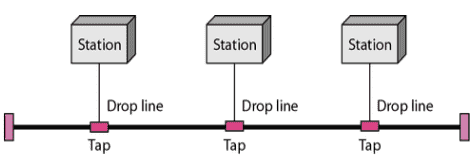 | 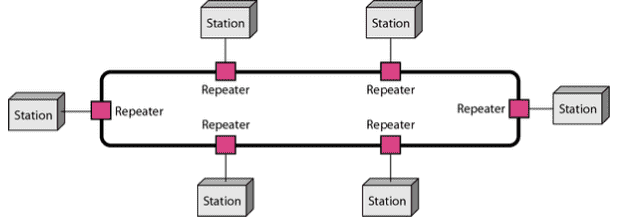 | 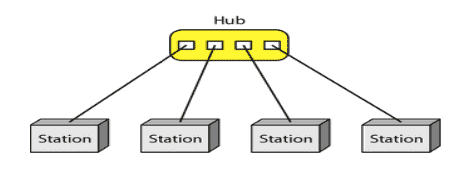 | 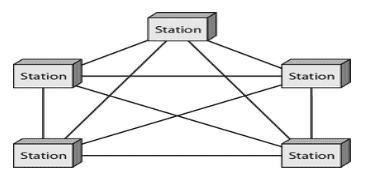 | 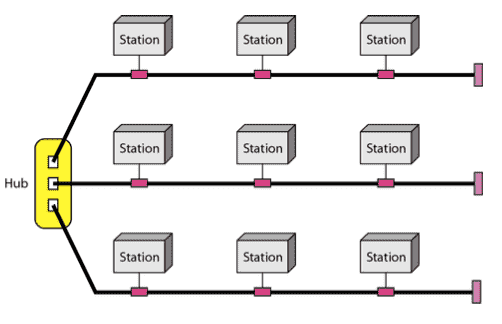 |
Network Devices¶
| End Points | PCs, Servers, Printers, etc |
| Interconnections | Media, Connectors NIC(Network Interface Card)/LAN Card/Ethernet Card) |
| Bridge | (not used anymore) |
| Switches | Connects endpoints to LAN Multi-Port Bridge |
| Router | Connect multiple LANs to form internetworks Chooses best path between LAN & WAN |
| Repeater | Repeats Token in a round-robin fashion Helps overcome signal attenuation |
| Hub | Device without any intelligence Multi-port repeater Not used much anymore It will just broadcast every packet, as it cannot select devices. |
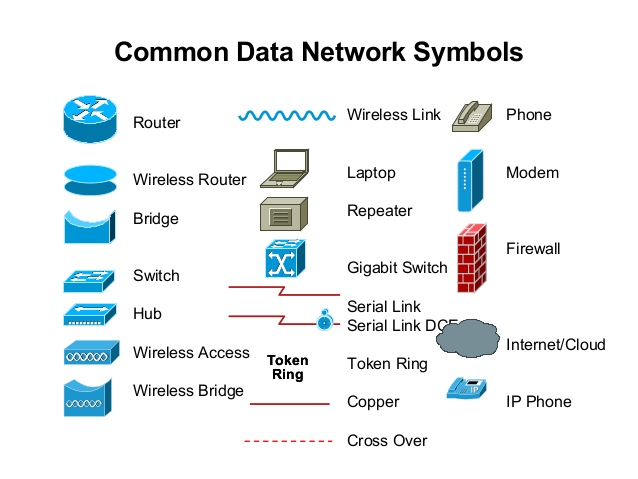
Network Rules¶
Protocol¶
Consists rules for the following aspects
| Aspect | Meaning |
|---|---|
| Syntax | Format of data |
| Semantics | Meaning of each section of bits |
| Timing | Timing and speed of data transfer |
The Internet¶
Network of networks, consisting of
- Connected computing devices
- communication links
- Routers
- Protoctols
- Communication infrasture for distributed applications
- Communication services
Standard¶
Collection of protocols agreed by organizations, such as ITU, IEEE
| De Facto Standards | De Jure Standards |
|---|---|
| Approved by organizations | Adopted through widespread use |
For eg
- Wired LAN uses standard
IEEE 802.3 - WiFi (WirelessFidelity) uses standard
802.11
Internet Standards¶
- Internet draft
- RFC (Request for Comment)
Models¶
| Model | Example | |
|---|---|---|
| Client-Server | 1 Client 1 Server | WWW |
| Peer-to-Peer | End devices use each other’s resources | Torrenting Teleconferencing |
Types of Services¶
| Connection-Oriented | Connection-Less | |
|---|---|---|
| Stages | 1. Set up connection 2. Receive acknoledgement 3. Send data 4. Receive acknowlegment 5. Repeat steps 3-4 | Send data |
| Reliable | ✅ | ❌ |
| Flow Control | ✅ | ❌ |
| Congestion Control | ✅ | ❌ |
| Speed | Slower | Faster |
| Example Protocol | TCP (Transmission Control Protocol) | UDP (User Datagram Protocol) |
| Example Applications | HTTP (WWW) FTP (File Transfer Protocol) Telnet (Remote Login SMTP (Simple Mail Transfer Protocol) | Streaming media Teleconferencing Internet telephony |
Switching/Routing Mechanism¶
| Circuit Switching | Packet Switching | |
|---|---|---|
| Type | Physical | Logical |
| Dedicated circuit per call: telephone net | Data sent in discrete ‘chunks’ Each packet uses full link bandwidth | |
| Steps | - Establish physical connection - Network resources divided into pieces - Pieces allocated to calls - Data Transmission - Teardown | - Split data into packets - Transmit packets one hope at a time - Packet reaches receiver |
| Resource reservation | ✅ | ❌ |
| Resources allocated | Fixed | On-Demand (Dynamic) |
| Advantages | Line efficiency (Single link can be shared by multiple packets) Data rate conversion Packets are accepted even when network is busy (delayed, but still accepted) Priorities can be set | |
| Disadvantage | Resource piece idle if not used by owning call (no sharing) Call setup required | |
| Connection Type | Connection-oriented | Connection-less (Virtual Circuit Approach) Connection-oriented (Datagram Approach) |
| Total resource demand can exceed available? | ❌ | ✅ |
| Congestion Control? | ❌ | ✅ |
| Performance guaranteed? | ✅ | ❌ |
Resource Division¶
- Frequency division
- Time division
- Code division
TDM¶
Time Division Multiplexing
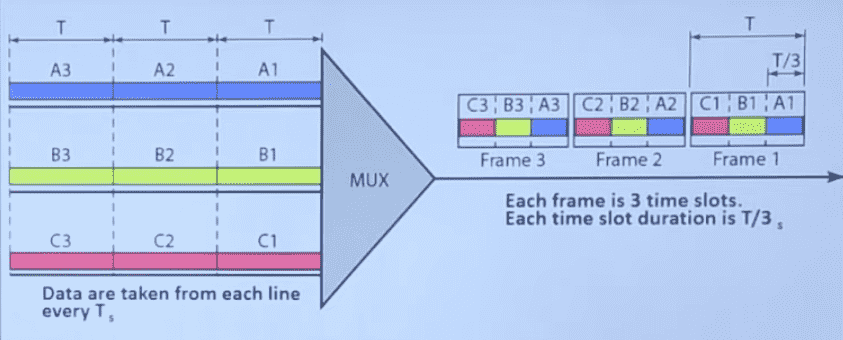
Subnet Mask¶
This is the value to perform and operation
To get the value, just make the network bits of the IP address as 1s and host bits as 0s